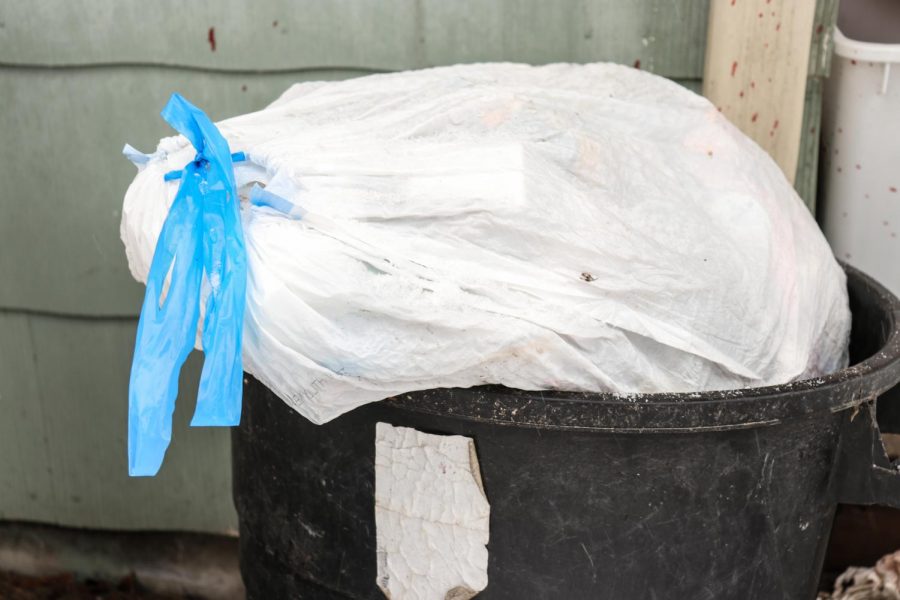Surge of landfill waste needs to be handled
Pullman produces more waste than it should, needs better organized system
JACK LEWIS-CLARKE | EVERGREEN PHOTO ILLUSTRATION
There’s plenty of reusable material in the waste bins destined for landfills. If more people were aware of what among our trash is reusable, more could be properly filtered and recycled.
February 20, 2019
In the U.S., we don’t typically see what happens to our trash after we throw it away.
Managed more for convenience than sustainability, waste is shipped to landfills all over the world and dumped just out of sight. However, by 2030, China’s Green Fence policy will displace over 111 metric tons of plastic meant for landfills, according to a research article by Science Advances.
China’s ban on plastic waste imports took effect in January, leaving the U.S. and others to manage more of their own garbage. No one enjoys dealing with waste, but without effective means to handle it, landfill sizes and numbers will continue to increase. This leaves towns and cities like Pullman to take responsibility for their waste now or be overrun by it later.
Pullman has a very large community and with that size comes a lot of garbage. Nearly three-quarters of WSU’s waste is recycled, but everything recycled goes to the same place to help with sorting. While this effort helps, too much of it just becomes trash. The Pullman campus’ many recycling bins and areas for compost help limit the amount of litter, not the amount of total waste.
Scott Beckman, associate professor of mechanical and material engineering, is familiar with the difficulties of recycling in waste management.
“Recycling of materials lets you have materials in a separate form,” Beckman said.
Plastic, metal, glass and paper are the most recyclable materials, but the composition of these products is not universal. The polymers in a plastic bag are different than those in a plastic cup, metals are typically a part of larger products with different materials, and papers can have a variety of chemicals that make their recycling process difficult.
A lot of students try to recycle what they use but it is hard when you are unsure where materials should go. Bins across campus list general materials of what should go where in the separate landfill, recycling and compost sections.
“The real issue is the social form,” Beckman said. “How are you gonna get people to recycle things like mixed paper, for example.”
Some trash is not listed and may be recyclable but will ultimately end up in the trash. Most students won’t go out of their way to recycle something and if students want a recycling bin for their house, they need to pay for their own. Regardless of this, many still pay the price.
“I recycle all cans and bottles whenever I can,” said Ryan Gregor, a senior majoring in construction management. “[I] have a recycle bin in my apartment that I fill regularly.”
There is a lot of waste in the community and we need to make sure everything is done to prevent further landfill build up. Recycling at home is good practice for maintaining a cleaner world, but we should encourage the maintenance required for a cleaner community. But small communities like Pullman shouldn’t be the ones to front these costs.
There should be a campaign for products with simpler labels of what kind of material they use. This should pair with a more organized system to divide them by.
The current method is to have all recycled material sorted on a conveyor system, a system which could be much more efficient if people were expected to sort their waste beforehand into organized bins. These bins would still need to be checked, but it would require less manpower to do so and would leave more workers to filter through waste meant for landfills that could hold recyclables.
With less waste entering our landfills, it helps stop the increased flow coming from China’s new policy. If recyclable materials are clearly labeled, more citizens will take to recycling as it becomes easier, making the worlds waste a little more useful.























Gene Patterson • Feb 20, 2019 at 9:20 am
Glass bottles and other glass waste are no longer recycled in Pullman by WSU or Pullman Disposal due to the low price of glass. It is cheaper to landfill it than to recycle it unfortunatley.